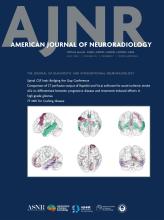We read with interest the recent article by Yoo et al.1 The definition of venous-predominant (vp) AVM used by Yoo et al applies to both type 1 and 2 arterialized developmental venous anomalies (DVAs) as described by Ruiz et al.2 These phenotypes are associated with a hyperemic capillary blush in the venous drainage territory of the caput medusa, which is incompatible with the diagnosis of AVM because circulating blood reaching the anomalous venous structures has already crossed a parenchymal capillary bed.2 The basis of the hyperemic capillary blush or tissue stain is not fully known. Some authors have attributed it to an adaptive ectasia of postcapillary venules, which enables redistribution of flow toward the hyperplastic collecting vein of the DVA. Nonetheless, the terms “arterialized” and “arteriovenous malformation” are both misleading in this context because arteriovenous shunting is not a feature of these atypical DVA phenotypes.
In their study, Yoo et al1 retrospectively analyzed patients with DVA or vpDVA who underwent MR imaging with arterial spin-labeling (ASL) sequences and catheter-directed DSA. The authors used DSA to quantify arteriovenous shunting on the basis of the temporal phase in which the lesions were visualized. This approach is fundamentally flawed according to criterion standard diagnostic principles. Although the rate of appearance of a draining vein can be used to quantitatively estimate a shunt when arteriovenous shunting is present, the presence of a shunt is not defined by the rate of appearance of a vein on a temporal scale, rather it is determined by the appearance of a draining vein before the regional capillary blush. If a capillary blush precedes the appearance of the draining vein, then arteriovenous shunting is excluded. In the absence of a true arteriovenous shunt, the rate of appearance of a draining vein is simply a measure of tissue transit time. The findings of the index study, therefore, correlate ASL signal enhancement with tissue transit time, rather than arteriovenous shunting, which is a distinct cause of ASL signal enhancement. We disagree with the authors when they conclude that ASL imaging predicts the amount of arteriovenous shunting. ASL signal enhancement has been found in numerous lesions with increased blood flow but without arteriovenous shunting, including tumors and inflammatory disorders.
In Figs 1 and 2 from the study, it is shown that the vpAVM phenotype is characterized by a hyperemic capillary blush on DSA. This finding definitively excludes arteriovenous shunting and eliminates AVM from the differential diagnosis. Nonetheless, Yoo et al1 have demonstrated that an atypical DVA with parenchymal hyperemia can be identified on the basis of increased flow-related signal enhancement on properly protocoled ASL imaging studies. Because this subgroup of atypical DVAs has been associated with an increased risk of cerebral hemorrhage, ASL sequences could be helpful in the evaluation of a DVA.
Footnotes
Disclosure forms provided by the authors are available with the full text and PDF of this article at www.ajnr.org.
References
- © 2024 by American Journal of Neuroradiology












